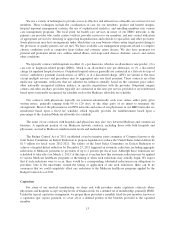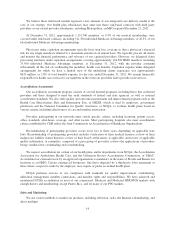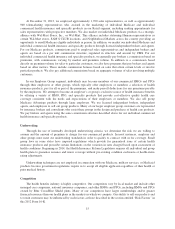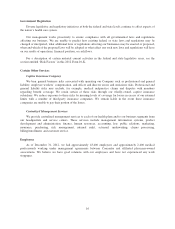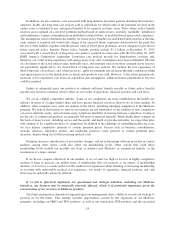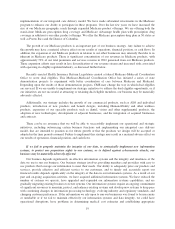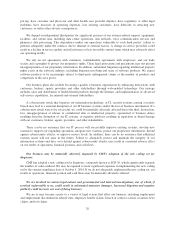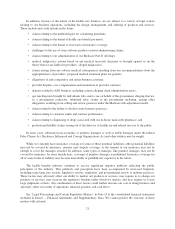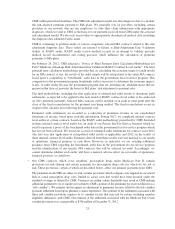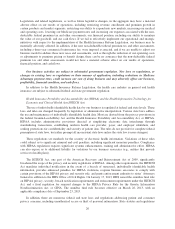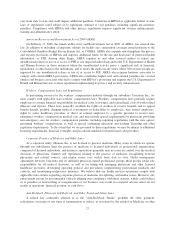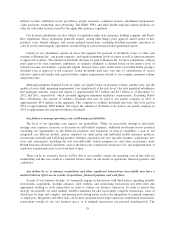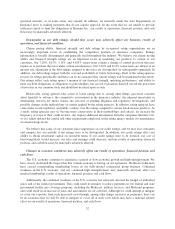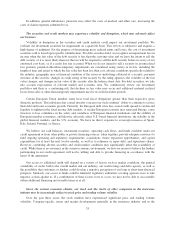Humana 2012 Annual Report Download - page 33
Download and view the complete annual report
Please find page 33 of the 2012 Humana annual report below. You can navigate through the pages in the report by either clicking on the pages listed below, or by using the keyword search tool below to find specific information within the annual report.CMS within prescribed deadlines. The CMS risk-adjustment model uses this diagnosis data to calculate
the risk-adjusted premium payment to MA plans. We generally rely on providers, including certain
providers in our network who are our employees, to code their claim submissions with appropriate
diagnoses, which we send to CMS as the basis for our payment received from CMS under the actuarial
risk-adjustment model. We also rely on providers to appropriately document all medical data, including
the diagnosis data submitted with claims.
CMS is continuing to perform audits of various companies’ selected MA contracts related to this risk
adjustment diagnosis data. These audits are referred to herein as Risk-Adjustment Data Validation
Audits, or RADV audits. RADV audits review medical records in an attempt to validate provider
medical record documentation and coding practices which influence the calculation of premium
payments to MA plans.
On February 24, 2012, CMS released a “Notice of Final Payment Error Calculation Methodology for
Part C Medicare Advantage Risk Adjustment Data Validation (RADV) Contract-Level Audits”. The final
payment error calculation methodology provides that, in calculating the economic impact of audit results
for an MA contract, if any, the results of the audit sample will be extrapolated to the entire MA contract
based upon a comparison to “benchmark” audit data in the government fee-for-service program. This
comparison to the government program benchmark audit is necessary to determine the economic impact,
if any, of audit results because the government program data set, including any attendant errors that are
present in that data set, provides the basis for MA plans’ risk adjustment to payment rates.
The final methodology, including the first application of extrapolated audit results to determine audit
settlements, is expected to be applied to the next round of RADV contract level audits to be conducted
on 2011 premium payments. Selected MA contracts will be notified of an audit at some point after the
close of the final reconciliation for the payment year being audited. The final reconciliation occurs in
August of the calendar year following the payment year.
Estimated audit settlements are recorded as a reduction of premiums revenue in our consolidated
statements of income, based upon available information. During 2012, we completed internal contract
level audits of certain contracts based on the RADV audit methodology prescribed by CMS. Included
in these internal contract level audits was an audit of our Private Fee-For-Service business which we
used to represent a proxy of the benchmark audit data in the government fee-for-service program which
has not yet been released. We based our accrual of estimated audit settlements for contract years 2011
(the first year that application of extrapolated audit results is applicable) and 2012 on the results of
these internal contract level audits. Estimates derived from these results were not material to our results
of operations, financial position, or cash flows. However, as indicated, we are awaiting additional
guidance from CMS regarding the benchmark audit data in the government fee-for-service program
and the identification of our specific MA contracts that will be selected for audit. Accordingly, we
cannot determine whether such audits will have a material adverse effect on our results of operations,
financial position, or cash flows.
• Our CMS contracts which cover members’ prescription drugs under Medicare Part D contain
provisions for risk sharing and certain payments for prescription drug costs for which we are not at
risk. These provisions, certain of which are described below, affect our ultimate payments from CMS.
The premiums from CMS are subject to risk corridor provisions which compare costs targeted in our annual
bids to actual prescription drug costs, limited to actual costs that would have been incurred under the
standard coverage as defined by CMS. Variances exceeding certain thresholds may result in CMS making
additional payments to us or require us to refund to CMS a portion of the premiums we received (known as a
“risk corridor”). We estimate and recognize an adjustment to premiums revenue related to the risk corridor
payment settlement based upon pharmacy claims experience. The estimate of the settlement associated with
these risk corridor provisions requires us to consider factors that may not be certain, including member
eligibility differences with CMS. Our estimate of the settlement associated with the Medicare Part D risk
corridor provisions was a net payable of $356 million at December 31, 2012.
23


